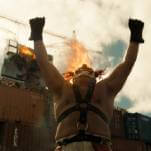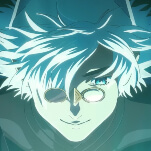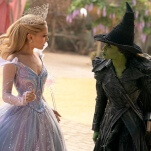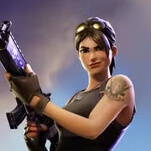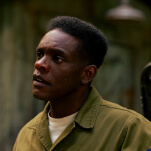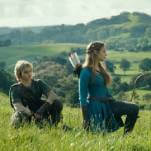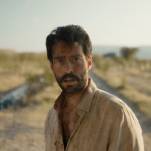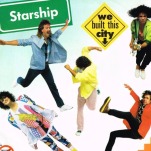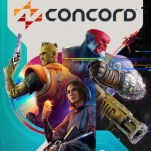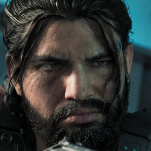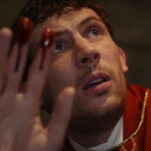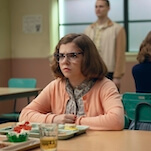DC is going big for its newest Superman offering, uniting two of their highest-profile creators for a title that emphasizes the sheer force of its iconic hero. Four pages into Superman Unchained #1 (DC), there’s a splash page of Superman flying into a falling satellite that is actually a fold-out poster, a gimmick that lends itself to a striking visual, but doesn’t do much for the reading experience. (Reading the poster is especially uncomfortable if you don’t want to detach it from the comic book.) The logic is understandable considering Jim Lee’s talent for drawing explosions and superheroes in action, but it also takes away six pages that could have been used to expand on Scott Snyder’s story.
With his other DC superhero work, Snyder has shown a strong understanding of the fundamental principles governing the publisher’s heroes and created villains that challenge those ideas. Batman knows Gotham City like no one else until he meets the Court Of Owls, a secret society that has been controlling the city for Bruce Wayne’s entire life. Swamp Thing is an agent of The Green, the force of all plant life, so he’s pitted against The Rot, the force of decay. Superman is an alien on Earth, giving him power and perspective that lead him to a life of helping others in an effort to be accepted by his adopted home world. He’s a free agent that operates on a higher moral plane than those around him, but what if there was someone with his power that didn’t mind being used as a weapon? What if there was another Superman in the employ of the U.S. military, used for the past 75 years for missions like the obliteration of Nagasaki?
The introduction of a military Superman is a smart nod to the character’s 75th anniversary and history as wartime propaganda (the Fleischer Superman animated shorts provide some prime examples), although time will tell if this new character is more than just atomic power trapped in a man’s body. For a villain with more complexity, Snyder includes everyone’s favorite billionaire super-criminal Lex Luthor, who is on his way back to prison when Superman questions him about all the stuff falling to Earth from space. Snyder has a great handle on Lex’s voice, creating a self-righteous, dismissive, and deluded megalomaniac who is the polar opposite of the endlessly sympathetic and welcoming Superman.
Removing Clark Kent from the Daily Planet was an ill-conceived story development of The New 52, but Snyder finds a way to include Jimmy Olsen, Perry White, and Lois Lane in his story. Not surprising, it’s the issue’s strongest scene, spotlighting Clark and Jimmy’s friendship, Lois and Clark’s flirtation, and Perry and Lois’ playfully aggressive work relationship in just a few pages. The Clark Kent side of Superman has been woefully underdeveloped in The New 52, and hopefully Snyder will provide Superman with the introspective character development that has made his American Vampire and Batman runs so successful.
This issue proves that Jim Lee can handle subtler emotional storytelling along with widescreen spectacle, and the ability to pull off that juggling act is what makes or breaks any new Superman creative team. The “man” element must be equal to the “super” or the character becomes boring to read; while this first issue definitely highlights Superman’s strength, Snyder and Lee capture enough of Clark Kent’s humanity to make this the strongest Superman launch since Grant Morrison’s Action Comics #1 back at the very beginning of The New 52. [OS]
Their style and tone are fairly different, but otherwise Jeffrey Brown’s
A Matter Of Life (Top Shelf) and Anders Nilsen’s
The End (Fantagraphics) take similar approaches to their subject matter, dealing with death and spirituality through a series of autobiographical vignettes. In
A Matter Of Life, Brown does as he has for most of his career, compiling short personal anecdotes—some funny and some painful. For
The End, Nilsen pulls pages from his sketchbook and adds previously published strips, compiling it all into an abstract art object that takes the form of a book. Both comics grapple honestly and artfully with what Nilsen once dubbed “Big Questions.”
A Matter Of Life raises those questions fairly subtly, peppering them lightly over a series of short comics that mostly describe what it was like for Brown to be raised as a preacher’s kid in Grand Rapids, Michigan. Brown writes and draws about his gradual loss of faith, as he discovered pieces of popular culture (science fiction and rock ’n’ roll in particular) that served as a rebuke to what he thought he had to believe. The book doesn’t proceed in chronological order; instead Brown bounces back and forth between his boyhood, his young adulthood, and his life now as the father of a son who’s starting to wonder about death. Brown’s panels tend to be small and his pages cramped, which enhances the even-handedness of his approach to the topics of religion and growing up. As Brown covers his persistent health woes (along with those of his father and son), and mentions how his personal experiences modified his views on topics like homosexuality and the value of art, he quietly examines how belief systems tend to be affected by individual need.
As for The End, it’s a follow-up to Nilsen’s heartbreaking collage-comic Don’t Go Where I Can’t Follow (recently reissued by Drawn & Quarterly in a nice new hardcover edition). The earlier book described the death of Nilsen’s fiancée; The End gathers remnants from the aftermath. Some of these pages contain depictions of Nilsen’s daily life after cancer took his partner, and some contain conversations between Nilsen and what he imagines her ghost to be. But other pages are just drawings of intricate patterns, or darkly comic ruminations on the meaning of life. This is a book from comics’ more avant-garde wing, and a premier example of how to make experimental work that still connects broadly, rather than coming across as self-indulgent vamping. Both Brown and Nilsen were part of the Chicago-based comics collective known as “The Holy Consumption,” so they’re not that far apart in sensibility. They just use different methods to regard the universal through the prism of the personal. [NM]
The 12-issue series
Solo was one of DC’s most fascinating experiments, spotlighting specific comic-book artists as they created a double-sized comic composed of short stories from a variety of genres. Some artists brought in writer collaborators, while others took full control over the story and visuals, making
Solo one of the best resources for a crash course in different types of comic-book storytelling.
Solo: The Deluxe Edition (DC) collects all 12 issues in a hefty hardcover package that should be studied in classrooms and showcased on coffee tables. It’s a celebration of the versatility and artistry capable within the medium, with a lineup of artists that covers a huge range of styles.
The graffiti-inspired work of Damion Scott is vastly different from the expressionist drawings and paintings of Teddy Kristiansen, but the stories show how the different styles are ideally suited for the content of the narratives. Scott’s work is explosive, chaotic superhero action drawn with a line that barely contains the intense energy of the warring characters, while Kristiansen renders more atmospheric, personal stories with the help of writers like Neil Gaiman and Steven Seagle. The best issues are by creators who take advantage of the project’s freedom to turn their installments into their own personal zines, with Darwyn Cooke, Michael Allred, and Brendan McCarthy all showing off their unique sense of design.
The art is phenomenal but the writing on display is equally exceptional, from Sergio Aragonés’ finely tuned comic voice to Paul Pope’s ability to make any story hip, whether it’s the Greek myth of the Minotaur or a Silver Age pastiche starring Jack Kirby creation OMAC. DC superheroes aren’t used very often, but the results are immensely entertaining when they appear. Allred’s Hourman short story makes ingenious use of a nine-panel grid to hilariously simulate the hero’s 60-minute high, and the pairing of horror master Richard Corben with The Spectre for a story penned by longtime B.P.R.D. writer John Arcudi is truly inspired. Solo is the type of project that shouldn’t have ended after 12 issues, and in a perfect world, a surge of sales for this hardcover collection would make the company consider a relaunch of the book, possible over at Vertigo. There are certainly enough artists that deserve the spotlight, and it would be the ideal kind of book for the mature-readers imprint, giving the creators even more freedom to tell the exact type of stories they want. [OS]
Like Anders Nilsen, Dash Shaw has spent his career looking for a creatively profitable middle ground between high art and straightforward comics storytelling. Shaw’s new graphic novel,
New School (Fantagraphics), is provocatively named, suggesting something groundbreaking—which the book is to a significant degree. The title refers to a language school, on a mysterious island named X, where sheltered Jersey boy Danny journeys to find out what happened to his brother Luke, who’s been gone from home for years. When Danny arrives, he tries to pitch in with Luke on helping the locals finish their elaborate time-travel-themed amusement park ClockWorld (a sort of cross between EPCOT and Colonial Williamsburg). But Danny becomes disillusioned by the hypocrisies running through the purportedly conservative culture of X, so he begins to rebel, embracing this foreign land’s caricature of the loutish American.
Plot-wise, New School couldn’t be much more direct: Danny goes abroad, he flips out, and there are repercussions. What’s unusual is the way Shaw constructs Danny’s character, as a kid who speaks in anachronistically formal English, even though he lives in a world of Jurassic Park movies, X-Men comics, and Taco Bell. And then there’s the odd style of Shaw’s art, which layers what looks like thick, rough magic-marker drawings with washes of color that grow more frequent and elaborate as the story plays out, reflecting how Danny’s simplified vision of the way life should be keeps getting muddier and more complex. Shaw riffs on the popular culture of the ’90s and the politics of the ’00s, suggesting that the children of one decade grew up too cut off from reality to understand the part they played in fostering the global conflict of the next. The social commentary in New School provides a sharp accent to a formally daring, at times alarming coming-of-age tale. [NM]
Gerard Way has been absent from the comic-book industry since
The Umbrella Academy: Dallas concluded four years ago, devoting time to his emo pop-punk band, My Chemical Romance, which released a
concept album and went on tour before the group’s dissolution this past March. His comic-book return,
The True Lives Of The Fabulous Killjoys #1 (Dark Horse), is a direct continuation of the narrative from the concept album that shares its title, and this first issue has about as much depth as an album that features songs with titles like “Na Na Na (Na Na Na Na Na Na Na Na Na)” and “SING.” The Killjoys were a group of heroes (played by My Chemical Romance in two
music videos) who sacrificed themselves to save a young girl, and this first issue picks up with the grown-up girl waking up in the desert years later. Co-written by Shaun Simon, it’s a standard rebellious-youth-vs.-oppressive-authority plot, set in a dystopian future where citizens are kept in check by Draculoids and Scarecrows that wipe their minds for crimes like listening to headphones too loud.
Way’s The Umbrella Academy did a phenomenal job introducing its setting and characters at the very outset, but the script of Killjoys puts too much stock in the reader being familiar with the story introduced in the album and its music videos. Leaning heavily on Way’s musical background, the story features poetic narration that might work as song lyrics, but doesn’t click on the page. Vital information gets lost in the future slang, and the language is representative of the story’s tendency to put style over substance. Way showed in The Umbrella Academy that he can provide a fresh take on superpowered characters while still creating complex character relationships, but Killjoys is largely lacking that personal element.
The highlight of the first issue is the smooth, trendy artwork from Becky Cloonan, which gives the characters a look that is one-part superhero, two-parts Hot Topic. The manga influence in her art creates dynamic action sequences, but it’s her design sense that makes her such a great fit for this title. The world of the Killjoys looks silly and a little cheap in My Chemical Romance’s music videos, but it comes to vivid life under Cloonan’s pen. [OS]
And…
The ’40s and ’50s were a time of great experimentation in the American comic strip, as cartoonists played around with minimalist design, wryer jokes, and different kinds of characters. Crockett Johnson’s Barnaby ran from 1942 to 1952, and while it never became a sensation, it remains a favorite among comics connoisseurs, who love its innovative use of white space and typeset dialogue, which together give Barnaby a distinctively clean look. Barnaby: Vol. 1 (Fantagraphics) collects the strip’s first two years, which introduced the accident-prone youngster Barnaby Baxter and his portly, cigar-smoking, wing-sporting “fairy godfather” Mr. O’Malley, whom Barnaby’s parents believe to be imaginary despite ample evidence to the contrary. Johnson (whose real name was David Johnson Leisk) went on to create the beloved children’s book Harold And The Purple Crayon, which has a similarly matter-of-fact take on a child’s imagination. With Barnaby, Johnson combined low-impact serialized adventure with some gentle comedy based around the ways that adults and kids diverge in their perspectives. The result is a compulsively readable strip with a winningly off-kilter point-of-view—and a cultural treasure that’s been long-overdue for this kind of prestige archival project… [NM]
If Doom Patrol was combined with the 1960s spy series The Avengers, the byproduct would look a lot like The Mysterious Strangers, a new ongoing by Chris Roberson and Scott Kowalchuk starring three people with extraordinary abilities who investigate the supernatural for an old guy in a wheelchair. Roberson’s work on iZombie revealed a skill for bringing a fun retro tone to stories that still have the depth of more contemporary comics, and The Mysterious Strangers has him shifting focus from horror conventions to superhero ones. There’s mind control, heroes in chains, ridiculously costumed henchmen, and a supervillain monologue outlining her entire scheme, but these traditional developments are scripted and drawn with a panache that comes across as reverent of the past rather than dated. Scott Kowalchuk’s artwork is heavily reminiscent of Javier Pulido, using a relaxed line that allows for immensely expressive characters while creating an exaggerated sense of movement during action sequences. The art really pops when combined with Dan Jackson’s color palette, which heightens the nostalgia factor with bright, saturated hues that were the norm in Silver Age comics. The first issue of The Mysterious Strangers was offered as Oni’s Free Comic Book Day offering, but if readers missed out on the opportunity to read it for free back in May, it’s still well worth checking out at cover price… [OS]
Alex Raymond was only in his mid-20s when he launched the newspaper strip Flash Gordon in 1934, and only in his mid-30s when he left Flash Gordon behind to enlist in the Marines. The strip grew up along with its artist, as Raymond learned to make his drawings bolder and simpler for newspaper reproduction, and as he and writer Don Moore began working real-world concerns into their science fiction, deepening the story about a studly Earthling who helps liberate the planet Mongo from a tyrant. Flash Gordon: The Fall Of Ming (Titan) collects Raymond’s final years of Sunday strips, when the hero defied Mongo’s SS-like stormtroopers and escaped its concentration camps, ultimately defeating the dastardly Ming before jetting back to Earth to lend a hand to the Allies in WWII. By the early ’40s, Raymond had refined his style, filling his big rectangular panels with subtly shaded, dramatically posed figures who looked like they stepped off a poster for U.S. savings bonds. (That The Fall Of Ming looks so good is due in large part to Peter Maresca, whose restorations of the original color strips couldn’t be lovelier.) What’s even more moving today is how strongly Raymond came out against fascism, illustrating the dignity of individuals as they struggle against the stranglehold of dictatorship… [NM]
Cartoonist David Chelsea has been a staunch proponent of the 24-hour comic, an experiment in spontaneous creativity that requires an artist to write and draw an entire 24-page comic in a single day. Everybody Gets It Wrong! (And Other Stories) (Dark Horse) collects six of Chelsea’s 24-hour jobs, and while none of them function especially well as stories, reading through them is a lot like flipping through a sketchbook, which is itself rewarding. Chelsea is an exceptional artist who hasn’t been as prolific as some, perhaps because his meticulous fusion of photo-realism with Winsor McCay-like whimsy takes time to craft. So it’s a treat to see how imaginative and detailed Chelsea’s drawings can be even when he’s working off the cuff. In Everybody Gets It Wrong!, Chelsea plays around with first-person perspective, wordless comics, funny animals, political satire, and other ideas that might’ve seemed too trivial to devote months of effort to, but that are worth trying for a day. Meanwhile, readers get to see a good cartoonist think through each page, as his thoughts go directly from brain to pen… [NM]
In the pages of X-Men: Legacy, Simon Spurrier has transformed David Haller, one of the most problematic characters in superhero comics, into a captivating leading man. That skill for reinvention is on full display in Six-Gun Gorilla #1 (BOOM!), a new six-issue miniseries inspired by a prose western that was published in British story paper Wizard back in 1939. Beyond the titular character, there’s little similarity between that original story and this new series, which adds a heavy dose of science fiction and socio-political commentary to the more traditional Western elements. The lead character of Spurrier’s script is an unnamed soldier fighting in a televised war, presented to viewers around the country looking for the ultimate thrill without going into combat. As the soldier makes his way through “The Blister,” he encounters a mysterious talking ape with two guns that somehow work in an environment where traditional combustion isn’t supposed to be possible. It might not sound like much of a plot, but it’s exquisitely realized by Spurrier and artist Jeff Stokely, whose work has the gritty realism and imaginative sci-fi design sense of artists like Sean Murphy and Matteo Scalera. The splash page of “The Blister” is a majestic desert landscape populated by warring troops (including giant tortoise tanks, which apparently exist outside the world of Saga), and the action has a kinetic energy that immediately establishes the intensely high stakes of combat. Six-Gun Gorilla is a comic that finds immense depth in a silly concept, proving that even the goofiest characters can be a part of meaningful stories… [OS]
The sixth and final volume of Ursula Vernon’s Hugo Award-winning adventure series Digger (Sofawolf) was completed a couple of years ago, finishing the story of Vernon’s intrepid wombat and her underground adventures in and around ancient temples. Witty, warm, exciting, and philosophical, Digger is very much in the mode of Jeff Smith’s Bone; and in the interest of trying to reach more of a Bone-sized readership, Vernon and her publisher Sofawolf have launched a Kickstarter campaign to collect all six volumes into one omnibus edition. They met their initial funding target in about a day, but have promised to add more to the finished book the further over the target they go. The drive will remain open for a few more weeks; and if nothing else it offers a good opportunity for fans to advance-order a copy of the big Digger, in a paperback, hardcover, or e-book edition. The collected version of this beautifully drawn, richly imagined fantasy comic should be out this fall. [NM]

